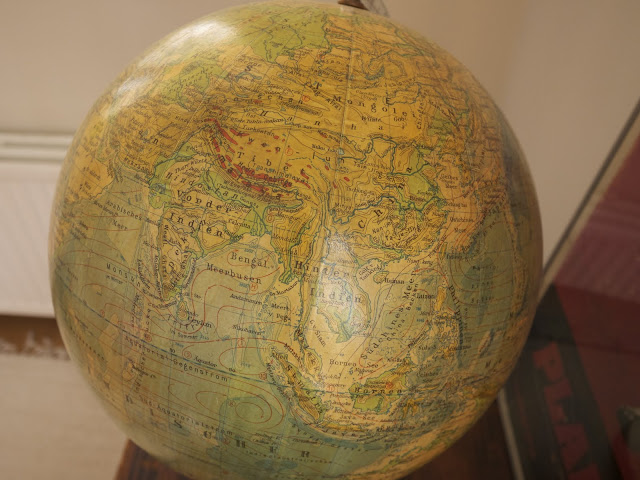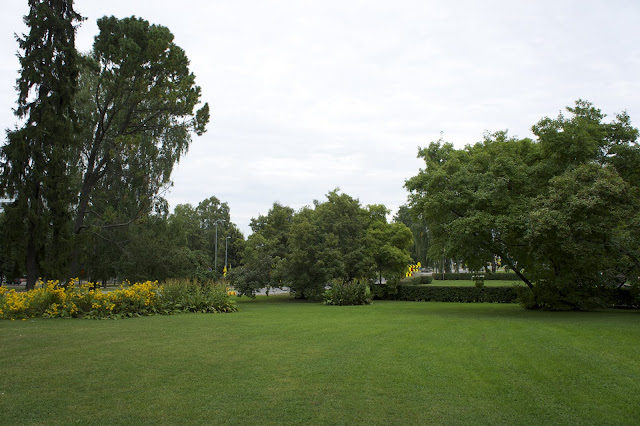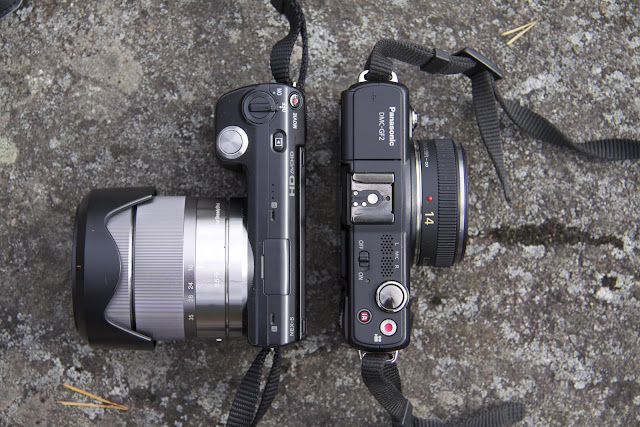While preparing this article, I shortly was tempted to write two articles - one for the Sony NEX-5 and one for the Panasonic Lumix GF2. Realizing that it would mean double the work and some repetition, I decided to scrap that idea and put both cameras into a Field Report Face-off, as this will give potential interested persons a much better idea of both cameras.
Me, being slightly obsessed with weight (that of gear!), I got out my lovely little digital scale, took both cameras apart and put them on it. My findings are presented in this neat little table:
The NEX-5 is thus defacto, with the battery included, without a lens, 16 gram lighter than the GF2. As I don’t have another lens for the NEX-5 (like the 16 mm pancake which Sony offers, claimed weight is 67 gram) the weight with lens is a bit off: the GF2’s 14 mm Pancake is inherently lighter than the NEX-5’s 18 - 55 mm lens, while the latter gives a tad more options in the zoom field. However, I need to do with what was loaned to me, so bear the difference of the lens in mind when reading this article.
Handling in the field
Probably the most important part. The GF2 fits easily in a hipbelt pocket of one or more liters volume, and the NEX-5 also fitted in my 1,5 liter hipbelt pocket. The cameras were only in a hipbelt pocket during travelling, though, as I carry the camera around my neck and shoulder with the strap, to have it close when a good photo presents itself. If you carry it anywhere else, you’ll not make as much photos, Period. Rain? Thanks to the use of umbrella windjacket, I can also photograph and carry the camera in the rain. If it gets really windy and rainy, the camera moves underneath the jacket, to protect it more from the elements while staying in reach.
The NEX-5 has a protruding handle, which lies nicely in the hand and gives me a good grip. I can easily operate the camera with one hand, and manipulate buttons with my thumb and index finger. With the lens on the left of the body, an uneven distribution of weight might be a concern, but in practice we’re speaking of a 526 gram camera - if you can’t hold that in one hand, you likely won’t be able to carry a backpack of four kilogram or more - so it really is no issue for me.
Panasonic gave the GF2 a very, very, very minimal grip on the right, but it has no use for me. I can operate the camera with one hand (balancing the GF2 on the palm of my hand, while navigating with my thumb and index finger - always half running the risk of dropping the camera), but it is not as comfortable as the NEX-5, and to manipulate settings on the GF2 I need both hands.
The On/ Off buttons on the GF2 is better. I don’t know why, but the On/ Off switch on the NEX-5 has a habit of switching itself on (and draining battery). That has happened a couple of times to me, and is immensely troublesome. I set the NEX-5 up to switch itself off after 60 seconds - the minimum. The GF2 has a Monitor-off which can be set to 15 seconds while the whole camera will then switch itself off after two minutes. Or, you switch the Auto LCD Off “Off”, which will set the camera sleep mode to 1 minute - like the Sony. The very interesting “feature” of the Panasonic is, that if you decide to photograph using their iA (intelligent Auto) mode, the Auto-off setting is magical overwritten and does not work anymore. I imagine that is a bug of sort, otherwise I can not explain myself this odd behaviour.
Both cameras survived the blistering cold very fine, and also the heat does little to them (Although the Sony gave me an “Let the camera cool down” message as I was using it for something like 20 minutes in the sun. Funny.). Bumping them into rocks, on the ground, and trees did them no harm, and also rain was no problem. Just make sure you don’t let them soak - photographing a few frames in the rain, however, is no problem.
The Menus on both cameras are good. They’re not Apple-like (which is the Benchmark for me), but they work. The Sony Menu is the winner in this battle, though: It is very well executed, with nice “hover” explanations, smooth animations, useful tips. The Panasonic Menu on the other hand appears in a functional 80s style. Here again there’s a difference depending on which shot-mode your in: Have iA on and the Menu is very limited, and you even won’t find some stuff. Have Aperture, Shutter or another Mode selected, and the whole Menu is there for you to navigate. I find this interesting - if I shot in iA I have one Setup page, go on a manual setting (Ap, S, M, whatever) and you have six Setup pages. Not good, Panasonic.
Battery life
The 2nd most important part of the equation. The NEX-5 which I had on loan didn’t have the best battery life. A normal day of shooting would bring the battery pretty rapidly down to under 50%, so two days of normal photographing are the maximum I get out of one battery. Add in shooting some videos, and you look at one day, and if you take a lot of photos and videos, then the battery will be done in half a day. In my opinion a spare battery is a must for the NEX-5 if you go for longer than a day out, to be able to have enough juice. And if you want to go out in the freezing cold, then you for sure want to take spare batteries with you.
The GF2’s battery on the other hand is pretty fantastic. I easily get four to five days of normal photographing with it, which is ace. If you add in video and photos, that goes down to three to four days, and if you go the intense way of shooting a lot of video and photos, the battery will serve you two days. Even in winter the GF2’s battery seems to be working still very well, and allowing me a day or two of intense shooting, more on a normal level.
My feeling is that the GF2’s battery live is thus better than the NEX-5’s battery live.
Photo comparisons
An not to underestimate point of comparing cameras is to compare photos. All the following photos were shot in RAW, were not manipulated but straight uploaded to iPhoto and then uploaded to the web via Picasa. I shot the first ones on Aperture Priority, and then on Full Auto to showcase its ability. All photos were shot with the help of a Tripod to get the exact same position and frame.

GF2, ISO 400, Exposure 1/10 sec, Aperture 3.5, Focal Length 14mm

NEX-5, ISO 200, Exposure 1/8 sec, Aperture 3.5, Focal Length 18mm

GF2, ISO 100, Exposure 1/100 sec, Aperture 3.5, Focal Length 14mm

NEX-5, ISO 200, Exposure 1/160 sec, Aperture 3.5, Focal Length 18mm

GF2 on Auto: ISO 100, Exposure 1/640 sec, Aperture 2.5, Focal Length 14mm

NEX-5 on Auto: ISO 200, Exposure 1/50 sec, Aperture 9.0, Focal Length 18mm

GF2 on Auto: ISO 100, Exposure 1/250 sec, Aperture 4.5, Focal Length 14mm

NEX-5 on Auto: ISO 200, Exposure 1/125 sec, Aperture 7.1, Focal Length 18mm

GF2 on Auto: ISO 100, Exposure 1/500 sec, Aperture 2.5, Focal Length 14mm

NEX-5 on Auto: ISO 200, Exposure 1/100 sec, Aperture 6.3, Focal Length 20mm
Both cameras make fine photos, and any weight conscious backpacker will find that either camera can produce stunning results (if the photographer is up to the task, obviously). I found taking photos of Aurora Borealis with the NEX-5 a breeze, and have taken some superb photos of sunrise and flora & fauna with the GF2.
I like the limitation of the Pancake lens on the GF2, as it makes me look at stuff in new perspectives. It is good in low light, and can make some fine bokeh effects. Photographing flowers and such close up is wonderfully easy with it, and it takes really nice scenery shots.
I like the possibilities of the 18 - 55 mm “Zoom” lens on the NEX-5. It gives possibilities to get a bit closer to your target, and with the adjustable screen you can frame your shot in new ways. It has a sweet “Background Defocus” setting on Automatic, which lets you choose between lovely bokeh effect or a crisp all the way photo.
Extras
The GF2 sports a Touchscreen on its back, with which you can focus on different areas of the framed shot or manipulate the settings. While I was skeptical of it at first, I slowly started to use the focus feature more and more, and really like it nowadays. The GF2 has a well-hidden Flash, which only comes out when you want it to pop up.
You can get a Electronic Viewfinder for it (the one I used with the <a href=”http://www.hikinginfinland.com/2010/04/panasonic-lumix-gf1-field-report.html”target=”_blank”>Lumix GF1</a>) as well as a fixed, optical, 24 mm Viewfinder, which I used for a bit before ditching it in favour of the screen. Panasonic has a whole range of fine lenses where you will find anything for you need. And they’re sweet. I had the 8 mm Fisheye with the camera on loan, and it is a nice lens to play with, but for commercial and blog photos I much prefer the two pancakes - with a preference for the 20 mm Pancake.
Sony gave the NEX-5 a screen which can be tilted up - to photograph something very low without crouching on the ground - or down - to photograph stuff above your head. The tilting screen ROCKS. I use it all the time, as it allows for unique perspectives and easier framing of shots. No touchscreen, but the main button is always easy to access to control stuff like timer settings, Depth of Field, and other hogwash. It has a Panoramic shot function, which allows for nice Panoramas without the need to stitch separate photos with some software together. That’s pretty nifty if one is a lot in the mountains.
For the NEX-5 Sony offers a whopping three lenses. The 18 - 55 mm I had, a 16 mm Pancake, and a Zoom. However, with an optional mount adaptor you can use the full range of Sony α system A-mount lens, including the digital SLR lens lineup, so then it doesn’t look that bleak anymore, in case you judge a camera by the amount of lenses you can get.
HD Video
Both cameras do FULL HD video. Which is nifty, to say the least, and for me nowadays a mandatory feature. Three examples:
Sony NEX-5:
Panasonic Lumix GF2:
And both combined:
I think both cameras are great for video. However, I value the NEX-5 slightly more, as I have it with a better lens for video and it does not try to Autofocus as much as the GF2, and also Sony’s adjustable screen is very useful for video.
Sound then. Both cameras capture Stereo sound, and do so fine. If it is windstill. And no other ambient noise is around. For my needs the sound has become one of the reasons to move on. Even if there’s fancy Wind Cut and Microphone adjustable settings, they don’t cut it. The NEX-5 has an external Mic which you can buy, I haven’t tried it, though it might help in solving the problem. I’m not aware of something similar for the GF2. But my needs aside (they’re a bit higher now that I am producing a complete series), for Review videos, shooting scenery and other outdoor related needs both cameras sound capabilities are fine. Just be aware that they tend to capture a lot of extra sound which you might not want.
Conclusion
With the GF3 already out, and the NEX-5N coming any moment now, those two cameras might seem already outdated. Personally, I don’t think so. Sure, the two new models sport some improvement over these two (Personally I find the GF3 not that interesting, and do prefer the GF1/ GF2 - the NEX-5N or NEX-7, however, are HOT), but then they will be more expensive, and now is also a great opportunity to get any of these two cameras for a very good price. I’m certain you’d want that I declare one of the two the winner. I won’t. Both cameras are technically perfect for the UL backpacker’s needs, and both have advantages and disadvantages.
NEX-5 Disadvantages: - short battery life - switches itself easily on - tends to expose a bit lighter
GF2 Disadvantages: - a tad heavier - less easy too handle - tends to expose a bit darker - interesting Menu & Auto-Off choices when photographing in iA
If you’re a hardcore Sony or Panasonic fanboy, you already would have made your pick. If you’re new to the world of interchangeable lens cameras, then let me tell you that with either of these two fine cameras you’d be very well of to shave a significant amount of weight from your photo gear while maintaining the possibility to shot excellent photos and video. The NEX-5 with a 16 mm lens is 6 gram lighter than the GF2 with a 14 mm lens. The GF battery is 14 gram lighter, thus if you take a 2nd battery, the GF2 is again in the lead.
If I’d buy the GF2, I’d go for the body + 20 mm Pancake lens. I’d get an extra battery or two for longer trips. I’d also like the Electronic Viewfinder for bright days, and the 100 - 300 mm lens.
If I’d buy the NEX-5, I’d go for the exact camera I had (thus with the 18 - 55 mm lens). I’d totally get two extra batteries. I’d also get the 16 mm lens for when I don’t need any zoom.
Those who think to upgrade from a GF1, I personally would only do it if Full HD is a MUST. If not, invest the money into new lenses or go on a nice trip.
That’s it, really. The Panasonic lenses rock, the NEX-5 adjustable screen rocks, they’re both light, both make ace photos and videos, the both are small, and they both are a splendid tool to document your hiking, packrafting, skiing, climbing and backpacking adventures. You won’t regret buying either. If you got questions, well, that’s what the comments are for, right?
What others say:
<a href=”http://www.beuteltiere.org/”target=”_blank”>Basti</a> bought a GF2 before leaving to Iceland.
<a href=”http://www.backpackingnorth.com/”target=”_blank”>Mark</a> is an advocate of the GF1.
Buy yours:
| Sony NEX-5 | Panasonic GF2 |









